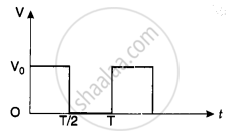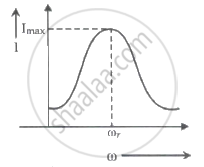Advertisements
Advertisements
प्रश्न
State any one difference between a direct current (dc) and an alternating current (ac).
उत्तर
While alternating current (AC) continuously changes direction at regular intervals, direct current (DC) only travels in one direction.
APPEARS IN
संबंधित प्रश्न
A 60 µF capacitor is connected to a 110 V, 60 Hz ac supply. Determine the rms value of the current in the circuit.
In any ac circuit, is the applied instantaneous voltage equal to the algebraic sum of the instantaneous voltages across the series elements of the circuit? Is the same true for rms voltage?
Why is choke coil needed in the use of fluorescent tubes with ac mains? Why can we not use an ordinary resistor instead of the choke coil?
If Im is the maximum current, then the average value of power dissipated in a resistance R over a cycle is ______.
The rms value of potential difference V shown in the figure is ______.

For a series LCR circuit, I vs ω curve is shown:

- To the left of ωr, the circuit is mainly capacitive.
- To the left of ωr, the circuit is mainly inductive.
- At ωr, impedance of the circuit is equal to the resistance of the circuit.
- At ωr, impedance of the circuit is 0.
An alternating voltage v(t) = 220 sin 100πt volt is applied to a purely resistive load of 50 Ω. The time taken for the current to rise from half of the peak value to the peak value is ______.
The r.m.s. value of alternating current is 10 A, having frequency of 50 Hz. The time taken by the current to increase from zero to maximum and the maximum value of current will be ______.
Draw graphs showing the variations of inductive reactance and capacitive reactance with the frequency of the applied ac source.
